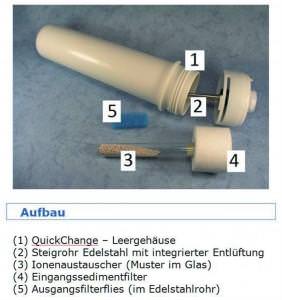Ingo K.: Is it true that nitrate cannot be removed from drinking water with a normal water filter, but only with a water ionizer?
However, there are filter cartridges with ion exchange resins that are misleadingly sold as nitrate filters. However, a filter medium is usually understood as something that removes substances from the water without adding anything else into it. The resin exchanges a nitrate anion for a chloride anion. Instead of nitrate, chloride comes into the water. This is not necessarily desirable in drinking water, but in the water ionizer it is subject to the same laws as all anions because of its negative charge Cl-, which means it stays primarily in the anode chamber with the acidic water, which also has a higher disinfectant effect due to the chloride than with the nitrate.
If the nitrate content is questionable (the official limit is 50 mg/l), one could consider using such an ion exchange resin upstream, as many critics consider the limit to be far too high.
But why are such cartridges not yet offered for water ionizers, but instead have to be installed externally in the water supply line?
Nitrate itself, as an important nutrient for plant growth, is generally not found in drinking water in quantities that are harmful to health. Since it has been a central component of fertilizers since ancient times, almost all plant foods have a high nitrate content of up to 4000 mg/kg. For example, if you eat a large radish (2000 mg nitrate/kg), you are consuming an amount of nitrate that would correspond to 40 liters of drinking water contaminated with the maximum permissible drinking water content of 50 mg.
After all, the Bavarian State Office for Health and Food Safety states that drinking water accounts for 26,3 percent of the average German's daily nitrate intake. Vegetables are at 61,7 percent, grain products at 4, fruit at 3,9, meat products at 3,7, dairy products at 0,8 percent.
The World Health Organization sees a health risk with a daily intake of more than 3,65 mg of nitrate per kg of body weight. A small child weighing 5 kg should consume no more than 18 mg of nitrate, and an adult weighing 75 kg should not consume more than 273 mg. Personally, if I have a diet rich in vegetables and therefore nitrates, I would consider a pre-filter with ion exchange resin if the nitrate content of the drinking water is over 38 mg/.
You can estimate this yourself using the following calculation method:
- Nitrate content of your drinking water mg/l, for example, 39 mg
- minus 1/3 reduction from the water ionizer = 26 mg
- x daily drinking amount liters of alkaline activated water, e.g. 2 liters = 52 mg nitrate intake through drinking water
- Body weight e.g. 78 kg * 3,65 mg/kg = 284 mg maximum recommended total nitrate intake
- This corresponds to a drinking water share of nitrate intake of 18,3%.
The statistical mean, on the other hand, is 26%. So I'm 3 percent below average. That's at least what I want because I like to eat a lot of vegetables and am therefore exposed to nitrates from food above average. If I didn't have a water ionizer, there would be 8 mg nitrate in the drinking water/day and therefore 78:78×284= 100%. That would put me 27.6 percentage points above the average, which I definitely don't want.
So I would use a denitration cartridge. This also removes sulfate anions, which often cause problems with the taste or smell of the water.
Such cartridges, here an example from Aquaphor®, are a one-time purchase because they can be regenerated with saline solution. If you follow my suggested calculation method, you will immediately see that the decisive factor for considering such a filtering method is your own body weight. The fewer kilograms you weigh, the less nitrate there should be in the water.
Finally, I would like to point out that the plant nutrient nitrate is usually not the main problem with drinking water quality. However, since the nitrate value in most cases indicates the use of fertilizer, for example through manure fertilization, it is considered a suspicion that the water also contains other substances from the agricultural world of pollutants, such as hormones, antibiotics, herbicides, pesticides, etc., which are not found in everyone Drinking water analysis can be presented or examined.

There is even a growing trend in medical research to end the decades-long demonization of nitrates in drinking water. Even the metabolite nitrite is gaining new recognition because the important vasodilating substance NO (nitric oxide) can be obtained from it in a natural process. Hydrogen researcher Tyler Le Baron gave me three examples of work (unfortunately only in English).
- Nathan S. Bryan even speaks of a therapeutic role in heart disease:
http://www.sciencedirect.com/science/article/pii/S0891584906003303 - The Brown Foundation at the University of Houston/Texas comes to the conclusion that the weak evidence of a cancer risk from nitrite, nitrate and sausage products should be outweighed by the much greater health benefits from the NO (nitric oxide) balance.
http://www.sciencedirect.com/science/article/pii/S1089860309001165 - A study by McNally, Griffin and Roberts provocatively asks whether a nitrate-rich diet is on the way to becoming a hero in metabolic diseases.
http://onlinelibrary.wiley.com/doi/10.1002/mnfr.201500153/full

The new reviews have already penetrated the active water scene. The American Kurt Ruppman Sr. has developed nitrate-rich hydrogen water in cans, which he offers under the name H2 Bev in various flavors (e.g. beetroot, lime). The values are promising. You still have to work on the taste...
Excerpt from the book by Karl Heinz Asenbaum: “Electro-activated water – An invention with extraordinary potential. Water ionizers from A – Z”
Copyright 2016 www.euromultimedia.de




